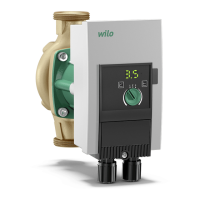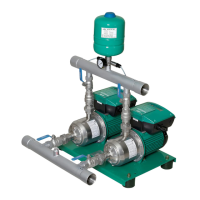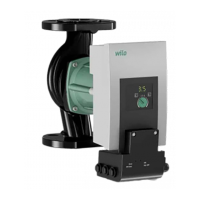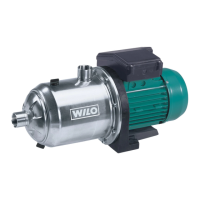Installation and operating instructions WILO Mather and Platt –MISO / PISO Pumps 16
7.2.3 Coupling Assembly
Install the coupling avoiding hard blows; if necessary
warm them for an easier fitting. Arrange the pump and
motor on a level base. The shaft ends must be perfectly
concentric. The distance between each half of the RB
(RATHI) coupling must be 2 - 3 mm. For spacer
couplings, the distance between shafts is mentioned in
&10-2 – value “X” (100 / 140 / 180mm.)
If other manufacturer couplings are used, follow the
manufacturer’s instructions. After installation on the
foundation and connecting the pipe work, the coupling
alignment must be checked and realigned, if necessary.
Moreover, after reaching the operating temperature the
alignment of the coupling must be checked again. The
coupling requires a guard that meets DIN31001 in order
to avoid accidental contact during operation.
In any event, the operating instructions of the coupling
manufacturer must be followed, since the coupling is a
component incorporated by WILO Mather & Platt.
Alignment of the pumps and its driving units
• When the base plate is leveled and the satisfactory
alignment is completed, proceed with connection of
suction & delivery piping. Recheck the alignment after
piping and run the final grout beneath the base plate.
Allow minimum seven days time for curing. Grout mix in
the proportion specified earlier for foundation bolt
grouting should be used. It is further recommended that
all hollow pockets in the base plate shall be filled after
curing of earlier grout.
• The following procedures outline recommended practice
given in BS-3170 in 1972 (Appendix A) for checking
shaft alignment. This method is independent of the
trueness of the coupling or shaft and is, therefore, not
affected by canted coupling faces or eccentricity of the
outside diameter of the coupling. Before commencing
the alignment, rotate each shaft independently to check
that the bearings run freely and that the shaft is true to
0.1mm or better. Check that no damage can be caused
when the shaft of the driven unit is turned.
• Coupling should be loosely coupled, and the halves must be
free to move relative to each other, Otherwise gauge
Indicators can be incorrect. Where, tightly fitting pins or
spring prevent loose the springs or pins should be removed
and a line scribed across both half couplings and readings
taken only when the two marks are aligned.
Radial Alignment
Clamp a dial gauge on one of the couplings or to the shaft as
shown in figure 5 Pg. No.4 with the plunger resting on the rim
of the other half coupling. Set the dial zero. Rotate the
coupling and note the reading at each quarter revolution. Any
variation in the readings indicates the deviation from
alignment and the position of one of the units must be
adjusted until the readings at each quarter revolution are
identical or within the tolerances given below. Refer figure 5
Pg. No. 4.
Alignment Tolerances
TIR: Total Indicated reading
CAUTION! Risk of material damage!
All the alignments (angular as well as radial) have to be
carried out by using 3 dial indicators, simultaneously.
Angular alignment
After isolating the driven unit from its power supply, clamp
two dial indicators at diametrically opposite points on one
half coupling or to the shaft behind it with the plunger
resting on the back of the other half of the coupling. Rotate
the coupling unit. The gauges are to be in line vertically and
set the dial to read zero. Rotate the coupling by 180
0
and
record the readings on each gauge. The readings should be
identical, though not necessarily zero. Either positive or
negative readings are acceptable provided they are equally
positive or negative. Adjust the position of one of the units
if necessary. Rotate the coupling unit. The gauges are to be
in the line horizontally and adjust the dial to zero. Repeat the
operation outlined above by rotating the coupling by 180
0
.

